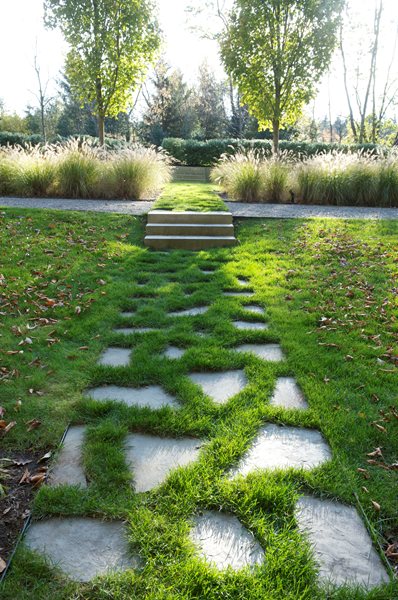The Art of Autumn
A garden in Pennsylvania kicks into high gear just as the growing season winds down. See how flaming fall colors and tawny grasses exhibit the season’s remarkable changes in depth, texture and color.

By mid-October, the modernist garden Lisa Roth designed in semirural Fort Washington, Pennsylvania, will be a luminous tableau. The clients' home, designed by Philadelphia architect Michael Ryan, is a sleek, contemporary interpretation referencing a traditional Pennsylvania farmhouse, comfortable enough in its setting to accommodate Roth's primary modus operandi: to let the land speak for itself.

The flaming colors of the surrounding deciduous forest intermingle with a tawny palette of grasses, and as the sun progresses across the sky, the garden exhibits remarkable changes in depth, texture and color.

It is a scene of painterly beauty, augmented by the clients' outdoor sculptures, which rise gracefully from the landscape. Such an artful sensory display is just what Roth, a landscape architect based in Devon, Pennsylvania, envisioned for the site. “I was taught to view landscape architecture as a mix of art and nature, a feeling that makes me believe that a designer needs to respect the land and at the same time not be timid about putting forward a vision.”

In the beginning, the owners of the four-acre property wanted the garden to be a slightly mysterious and aesthetically intriguing environment in which their large extended families could gather. Twelve years later, the garden has become that and something more: an outdoor gallery for a growing collection of contemporary sculpture.

“With this garden, I was able to be free of the stereotypes of suburban landscaping,” she says, “the grand entries, objectionable gates, the foundation beds, the boundary marking.” Roth exercised that freedom by creating an environment that is subtly overlaid with intellectual and artistic ideals.

Foremost among those ideals is a sensitivity to color and line, which is, in part, what makes this garden so suited to the seasonal splendors of autumn and early winter.

As the hazy days of summer are replaced by crisp fall weather, individual species become more visible, suddenly distinguished from the mass of greenery that defines the muddled depths of midsummer heat.

Color is everywhere, announced by the crimson, auburn and yellow of maples, beeches and yellowwoods, all breaking out of their conformist green to mingle with the phosphorescent gold and mauve of ornamental grasses waving in unison across the rolling landscape.

Then, when winter arrives, a new dimension takes shape: stark collages of pendulous berries, sculptural twigs and colorful bark.

This symphony of colors and textures did not come together overnight. When Roth first visited the site in 1997, it was consumed by construction activity, and the few trees remaining on the property were in survival mode. The task from day one was simple: Restore the meadow to a pastoral state and inject no fussy planting schemes.

Roth has an interest in art, so she appreciated the owners' desire for a minimalist landscape.

“Design concepts can be expressed in clear, powerful and memorable ways,” she says. Roth often uses an approach in which she edits away the extra details, steering clear of ornamentation so the true concept remains. Her designs get their strength from this expression of clarity rather than by embellishment or decoration.

Roth treaded lightly on the land, adding drifts of ‘Karl Foerster’ feather reed grass in the meadow to enhance the rolling quality of the ground plane—interventions, to be sure, but judicious ones. “If I had just let a wild meadow reestablish itself, you would not likely have noticed it.”
Roth's signature style—sweeping masses of single species—is a distinctly compositional gesture that provides scale and focus within a larger landscape.

To maintain privacy in this open landscape surrounded by large suburban-style homes, Roth supplemented the existing native vegetation with spot plantings of pin oak, yellowwood and paperbark maple. And though the planting scheme seems simple, it's not.

Adding outdoor sculptures to the scheme presented interesting challenges. By nature static and structural, sculptures would seem to be contrary to nature's whimsical variations. But Roth took advantage of that very tension, using the sculptures as counterpoints to the garden's natural progressions.

In spring, when the garden is comparatively bare, the sculptures add a colorful punch to the drowsy landscape.

In summer, hard metal edges offer a pleasing contrast to the soft masses of greenery engulfing the garden.

Autumn finds the artworks consumed by the fiery hues and frenetic energy of the quickly waning season. And finally, in the quietness of winter, the sculptures settle comfortably into the terrain, gently immersing themselves in a hibernating landscape.

Roth's is a highly managed minimalism, carefully attuned to the inherent nuances of a place. “As a designer, I want to find the right combination of site, architecture and client. The style of design is dependent upon that unique mix of factors.”

Continue for more photos of this Fort Washington, Pennsylvania garden.
See more gardens in Pennsylvania.












Goldenrod (Solidago sp.).


Fountain grass (Pennisetum setaceum).


Northern sea oats (Chasmanthium latifolium).


